This article is dedicated in memory of Haim Stier, who passed away in the course of our combined efforts to transfer his extensive collection of New Year cards to the Israel Museum. (Published at Issue 7, Tishrei 5772, October 2011)
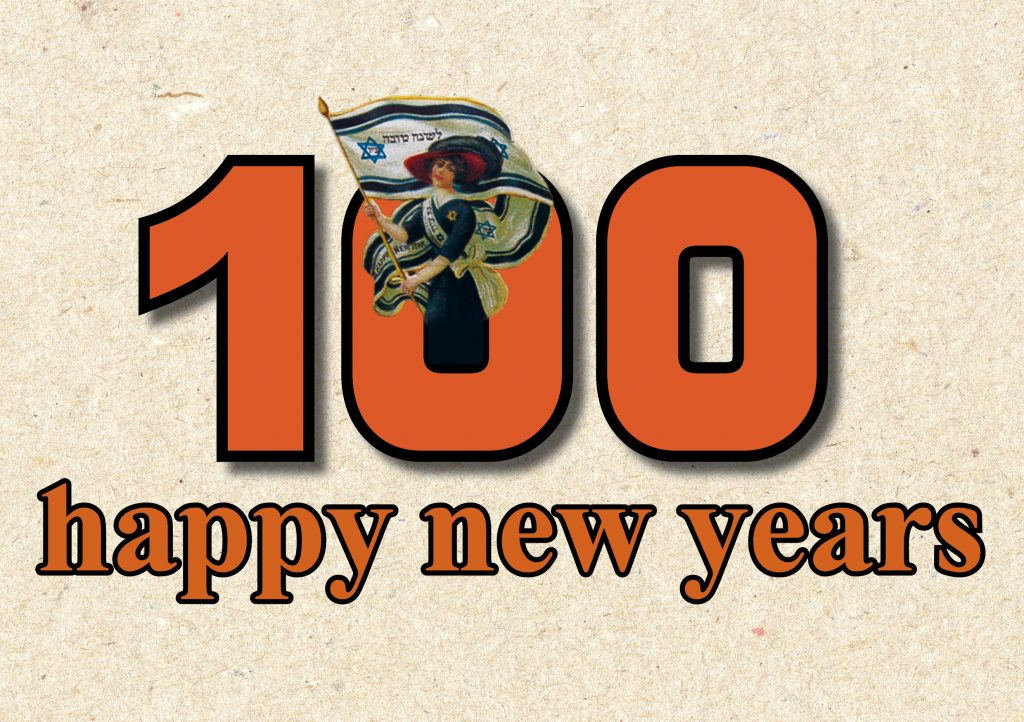
Thirty years ago, when sending out New Year’s cards was still a matter of course, who would have thought of making them the subject of an exhibition, let alone a museum exhibit. Progress, however, seems to have moved into fast forward in the last few years, and with the invention of social media, from fax to tweet, the Shana Tova card has rapidly become obsolete. At the same time, the historic, cultural and nostalgic value of what was once a common item, has increased enormously.
For close to a hundred years, Shana Tova cards have served as a heartwarming way of sending New Year greetings to family and friends. The custom originated at the end of the 19th century, with the invention of the postcard. These rapidly spawned greeting cards for Valentine’s Day, Christmas and New Years, a practice which the German Jewish community adapted , “converting” the greeting cards for Rosh Hashanah, the Jewish New Year. The custom spread throughout Europe, quickly reaching the growing concentrations of Jews in the United States and Palestine.
1910 – Kitsch and Tech
The motifs decorating a card bearing wishes for a successful year obviously had to reflect the similar sentiments. A wealth of such motifs included honey cake, flowers, birds, angels, or cornucopia, as well as images associated with the High Holyday prayers. One such card, illustrated here (Germany, circa 1910), combines a stylized ship, presumably symbolizing sailing into the future, flowers and a cantor complete with Torah scroll. Other cards from the first half of the twentieth century provide a fascinating record of the lifestyle of Jewish communities in Europe. Local artists painted or photographed figures from daily life, in addition to Jewish life cycle ceremonies and the festivals of the Jewish calendar. Contemporary technological innovations, such as the newly invented telephone, also featured prominently.
 Courtesy of the Israel Museum, Jerusalem, Haim Stier Collection
Courtesy of the Israel Museum, Jerusalem, Haim Stier CollectionSailing into the new year with flowers and emblems of the Jewish life-cycle
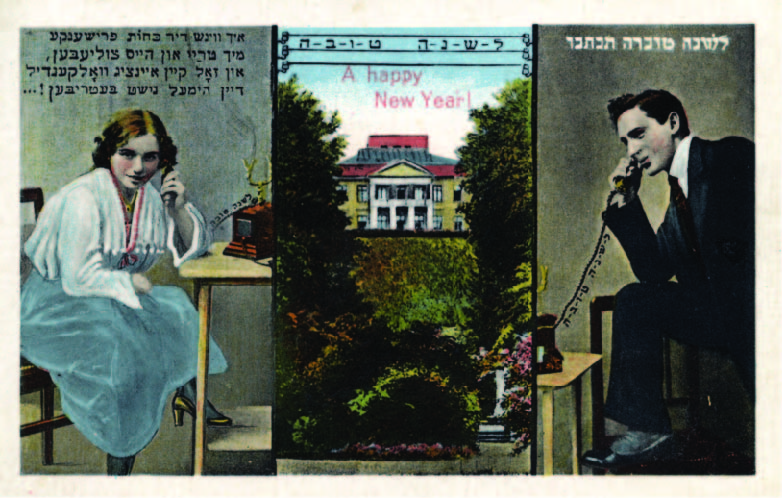 Courtesy of the Israel Museum Jerusalem, Haim Stier Collection
Courtesy of the Israel Museum Jerusalem, Haim Stier CollectionThe latest way to say “Happy New Year” – the newly invented telephone
1920 – Propaganda
Somewhat surprisingly, many Shana Tova cards carry depictions of the historical events of the past hundred years, decidedly one of the stormiest periods in Jewish history. The personal New Year’s message sent in many such cards was accompanied by a nationalistic motto with which presumably both sender and receiver identified.. All the sender had to do to make an ideological statement was to sign his name beneath the slogan of his choice and address the envelope. The result is a veritable visual overview of the key events of contemporary Jewish history.
The massive migration of Eastern European Jewry to the United States is reflected in numerous Shana Tova cards from the early decades of the last century. A immigrant ship is a frequent motif on these cards, which are consequently referred to as shifskarte. The Statue of Liberty or some other female figure is often depicted welcoming the crushed, dejected newcomers with open arms. This warm, welcoming message, was in fact little more than wishful thinking on the part of American Jewry hoping to encourage their persecuted brethren in Poland and Russia to join them. In fact, opposition to this type of mass immigration was building up within the United States administration, and from the late 1920s severe restrictions were placed on Jewish immigration. From then on, many of the migrants turned eastward – in the direction of Israel.
 Courtesy of the Israel Musuem Jerusalem, Haim Stier Collection
Courtesy of the Israel Musuem Jerusalem, Haim Stier Collection“Liberty” greets Jewish immigrants arriving by steamship in New York harbor
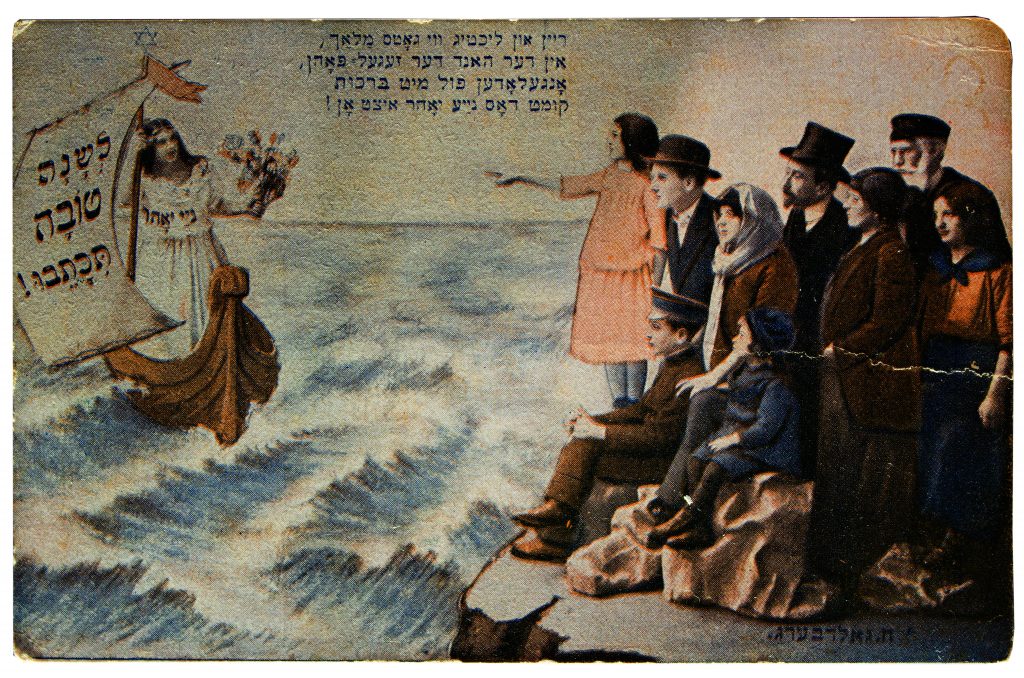 Courtesy of the Israel Musuem Jerusalem, Haim Stier Collection
Courtesy of the Israel Musuem Jerusalem, Haim Stier CollectionThe “New Year” arriving to transport her people into a better future
1940 – Personal Example
The Zionist movement used Shana Tova cards for its own propaganda purposes, and those produced for Zionist groups bore various Zionist symbols. Many Shana Tova cards had biblical motifs, to emphasize – in the spirit of the Zionist idea – the connection between the Jewish people and the Land of Israel, and the value of working the land. In place of “Miss America” in the Shana Tova cards, another female figure appears – Bat Zion, the daughter of Zion – who also carries the promise of an ideal life in the new homeland.
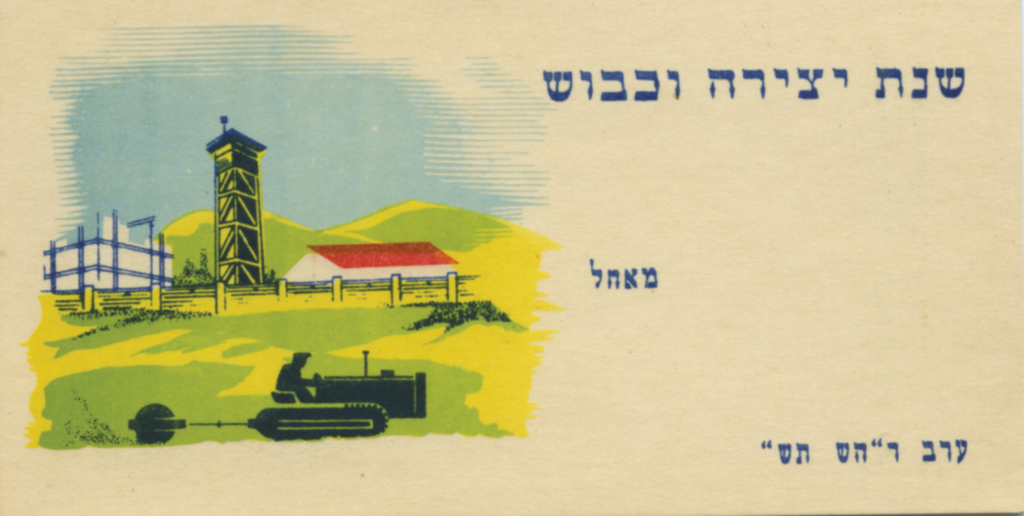 Courtesy of the Israel Musuem Jerusalem, Haim Stier Collection
Courtesy of the Israel Musuem Jerusalem, Haim Stier CollectionA year of building, planting and settlement – watchtower, stockade and plough
During the 1930s, residents of Tel Aviv would have themselves photographed, with vistas of the developing city behind them; these pictures would be sent to relatives abroad, with wishes for the New Year. Such pictures carried a message – sometimes overt and sometimes less so – calling for aliya to Eretz Israel.
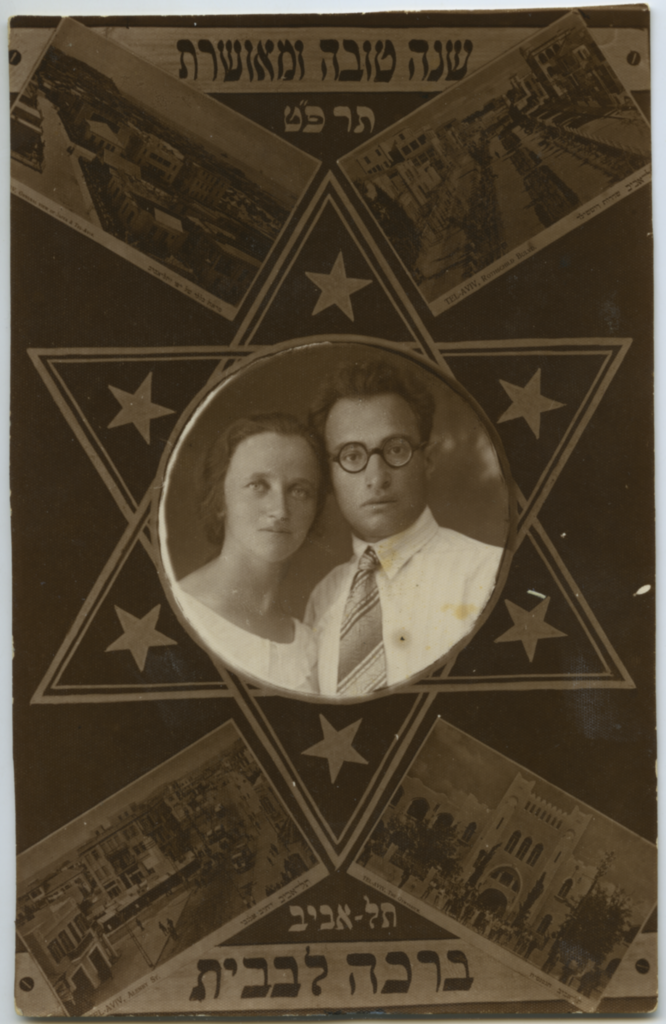 Courtesy of the Israel Musuem Jerusalem, Haim Stier Collection
Courtesy of the Israel Musuem Jerusalem, Haim Stier CollectionPersonalized, heartfelt New Year wishes from Tel Aviv
The Second World War and the Shoah led to a cessation of the production and distribution of Shana Tova cards in Europe. A bitter memory from those years remains in the Shana Tova cards that depict the survivors in the DP camps in Europe.
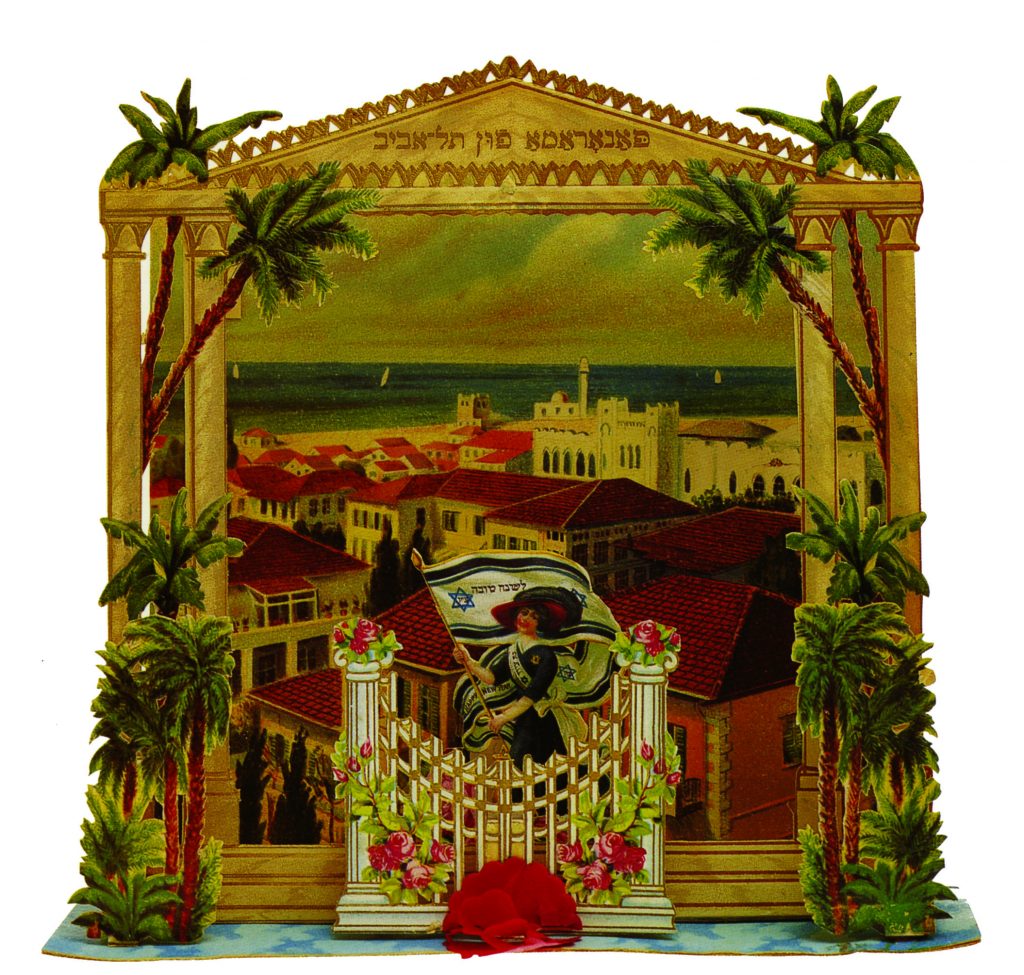 Courtesy of the Israel Musuem Jerusalem, Haim Stier Collection
Courtesy of the Israel Musuem Jerusalem, Haim Stier CollectionThe “daughter of Zion” replaces Miss America, bearing Zionist greetings from Tel Aviv
1950 – Ideological
The growing Jewish population in Eretz Israel became, toward the middle of the century, a dominant source of ideas for Shana Tova cards. Images of Jews praying, or working at the traditional occupations of the Eastern European shtetl, made way for the “new Jew.” With the establishment of the State of Israel and the outbreak of the War of Independence, a new image of the Israeli Jew was added – that of the Jewish soldier defending his land. Greeting cards from the 1950s often bore ideological messages relating to settling the land, hopes for its security, and even for expansion of its borders.
 Courtesy of the Israel Musuem Jerusalem, Haim Stier Collection
Courtesy of the Israel Musuem Jerusalem, Haim Stier CollectionA Happy New Year, fresh from the field
1960 – Militant and Broken
Due to the victory of the Israel Defense Forces in the Six-Day War, military motifs became a central element appearing on greeting cards produced in subsequent years. These cards depict soldiers, tanks and warplanes, alongside the heroes of that war – Moshe Dayan, Yitzhak Rabin and others – and sites such as the Western Wall, Me’arat Hamachpela and Rachel’s Tomb, which were now within the borders of the State. Many of these images were dusted with sparkling gold powder, which made the images appear even brighter.
 Courtesy of the Israel Musuem Jerusalem, Haim Stier CollectionPo
Courtesy of the Israel Musuem Jerusalem, Haim Stier CollectionPoPost Six-Day War New Year victory card
 Courtesy of the Israel Museum Jerusalem, Haim Stier Collection
Courtesy of the Israel Museum Jerusalem, Haim Stier CollectionSprinkles of gold dust sparkle on the stones of the newly accessible Western Wall after 1967
The military motifs disappeared immediately following the gloom of the Yom Kippur War. In the year following the war, a small but fascinating Shana Tova card was printed, depicting Prime Minister Golda Meir and President Zalman Shazar in a darkened room, with their silent expression offering no blessing toward the New Year. The choice of this image as a subject for a Shana Tova card is no less surprising than the fact that, out of habit, this card too was sprinkled with gold dust.
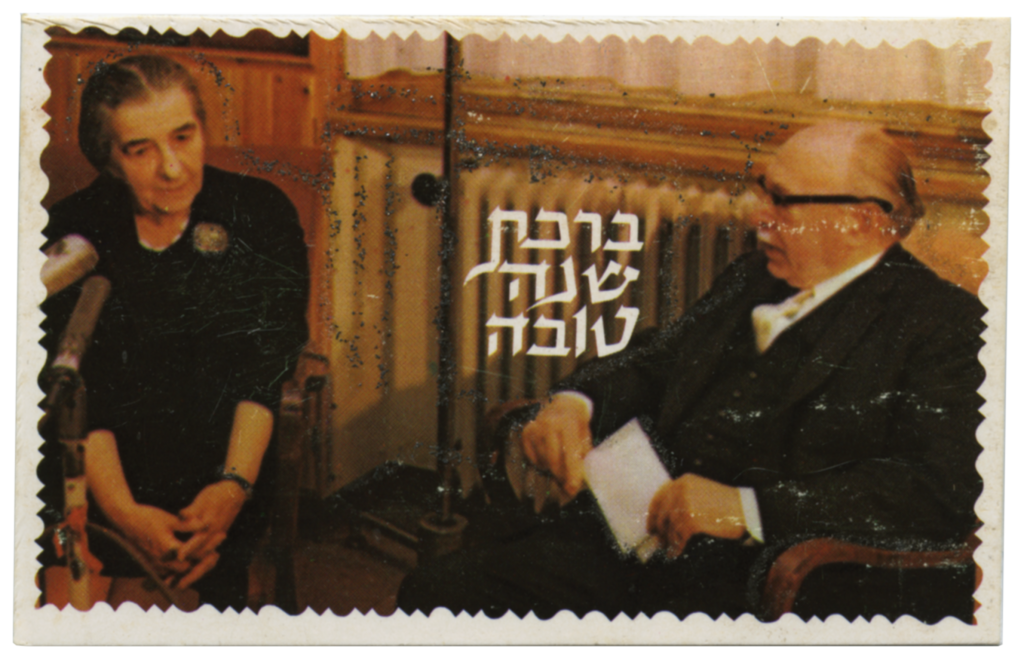 Courtesy of the Israel Museum Jerusalem, Haim Stier Colection
Courtesy of the Israel Museum Jerusalem, Haim Stier ColectionA year after the Yom Kippur War of 1973, politicians hope for a better year
1980 – Bourgeois and Musical
The seventies and eighties brought with them an openness to western culture, and a shift from nationalist, ideological messages to more personal, individual ones. Shana Tova cards from this period depict families sitting happily in their bourgeois living rooms. Cultural heroes such as the Beatles, Elvis Presley and others like them also became common motifs, along with images of romantic couples on a background of Israeli scenery.
 Courtesy of the Israel Museum Jerusalem, Haim Stier Colection
Courtesy of the Israel Museum Jerusalem, Haim Stier ColectionA Rockin’ Rolling year to all Elvis fans
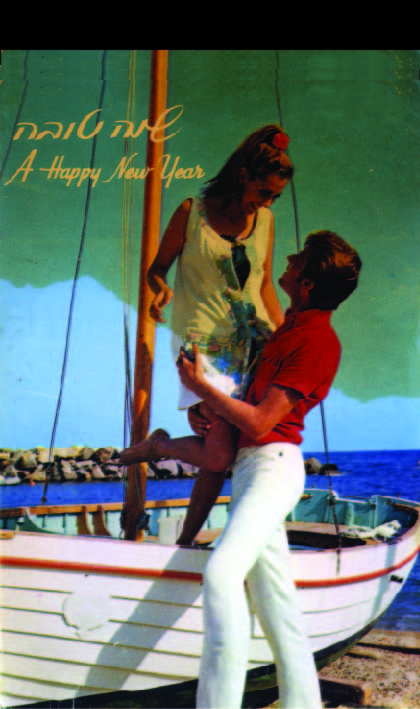 Courtesy of the Israel Museum Jerusalem, Haim Stier Colection
Courtesy of the Israel Museum Jerusalem, Haim Stier ColectionBest wishes for a year filled with love and romance
1990 – Political
Israel’s peace treaties with Egypt and Jordan, signed in the closing decades of the 20th century, signified, among other things, a return to contemporary political imagery on Shana Tova cards, such as this collectors’ item marking the peace treaty with Jordan.
 Courtesy of the Israel Museum Jerusalem, Haim Stier Colection
Courtesy of the Israel Museum Jerusalem, Haim Stier ColectionA year of shalom, salaam, peace
Rabin’s assassination in 1995 also became grist for the card-designers’ mill. Artist Ilan Molcho has issued a Shana Tova card thematically linked to this event each year, indicating the number of years that have passed since the prime minister’s death. Unlike traditional Shana Tova cards, which look forward to the approaching New Year, Molcho’s cards commemorate the past.
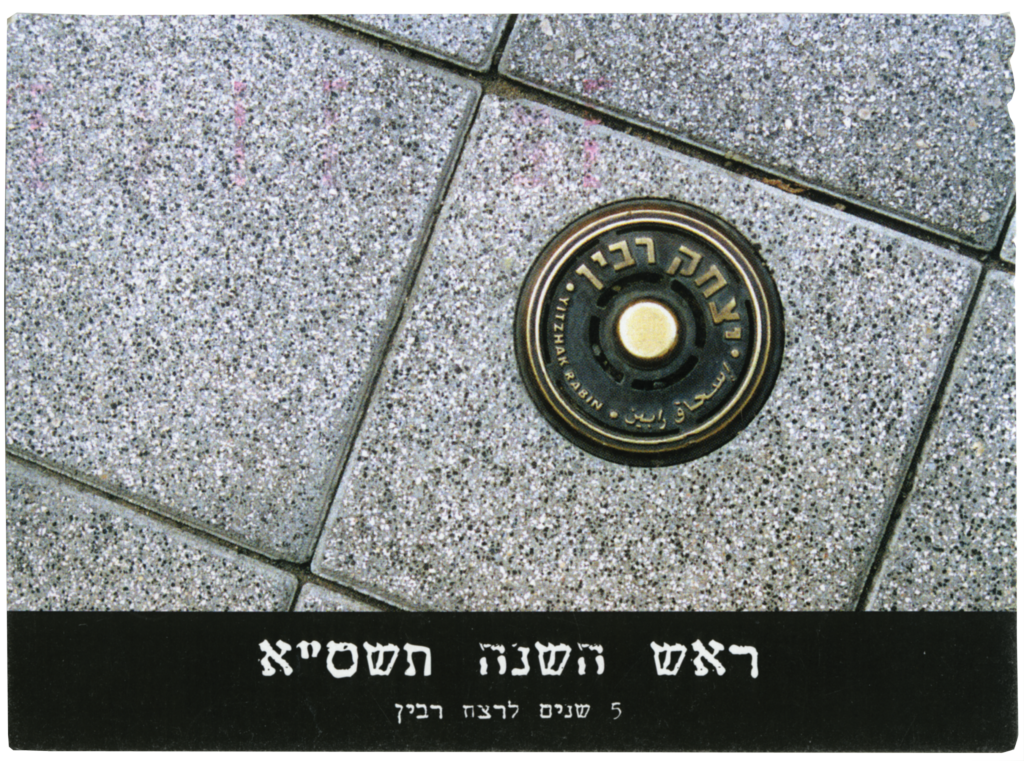 Courtesy of the Israel Museum Jerusalem, Haim Stier Colection
Courtesy of the Israel Museum Jerusalem, Haim Stier ColectionFrom hopeful wishes to mournful commemoration
Further reading:
Rahel Orbach, “Blue and White in Color – visuals images of Zionism, 1897-1947” (Exhibition Catalogue), Beth Hatefutsoth, Tel Aviv 1966;
Shalom Tzabar, “One Hundred Years of Shana Tova Cards: the History of the Custom and its Artistic Development,” in Bashana Haba’ah: Shana Tova Cards from the Kibbutz, Muki Tzur (ed.), Givat Haviva 2001 [Hebrew].
Shana tova!!!
